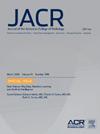美国医学院放射学师资提升趋势。
IF 5.1
3区 医学
Q1 RADIOLOGY, NUCLEAR MEDICINE & MEDICAL IMAGING
引用次数: 0
摘要
背景:教员晋升对于医学学术的保留和多样性具有重要意义。目的:我们旨在评估美国医学院放射学教师晋升趋势,并评估基于性别和种族或民族的变化。材料和方法:使用美国医学院协会教师名册,对2020年1月1日至2009年12月31日期间任命的全职教师(主要队列)进行了14年的随访,直至2024年1月1日。使用双变量分析,将晋升率和平均晋升时间按教师轨迹、性别和种族或民族进行比较。通过比较2010年1月1日至2016年12月31日任命的初级队列和二级队列的7年晋升终点,评估了最近的晋升趋势。结果:主要队列包括来自学术放射科的2,497名教师(182名讲师,1,589名助理教授和726名副教授),任命于2020年1月1日至2009年12月31日。临床教育专业教师的晋升率略高于传统专业教师(39.6%比36.4%,P = 0.116),但晋升时间明显长于传统专业教师(8.25比7.4年,P < 0.0001)。在临床教育专业的教师中,14年以上的晋升率女性(42.3%)高于男性(38.3%,P = .12)。女性助理教授的平均晋升时间(8.9年)明显高于男性助理教授(8.2年)(平均差距为0.65年,P = 0.013)。对于较晚近的教员群体来说,在7年的时间里,晋升率更高(助理教授为26%,而助理教授为15%,P < 0.001),而且无论男女,晋升的平均时间都更短(助理教授为5.7年,而助理教授为6.0年,P = 0.001)。结论:随着时间的推移,美国学术放射科的晋升率上升,晋升时间下降。男性和女性的晋升率相似。本文章由计算机程序翻译,如有差异,请以英文原文为准。
Trends in Academic Radiology Faculty Promotion in US Medical Schools
Background
Faculty promotion is important for retention in academic medicine and has implications for diversity.
Purpose
We aimed to assess faculty promotion trends in academic radiology in US medical schools over time and assess variations based on gender and race or ethnicity.
Materials and methods
Using the Association of American Medical Colleges faculty roster, full-time faculty appointed between January 1, 2020, and December 31, 2009 (primary cohort), were followed for 14 years till January 1, 2024. Promotion rates and average time to promotion were compared by faculty track, gender, and race or ethnicity using bivariate analyses. Recent trends in promotions were assessed by comparing 7-year promotion end points between the primary cohort and a secondary cohort appointed between January 1, 2010, and December 31, 2016.
Results
The primary cohort included 2,497 faculty (182 instructors, 1,589 assistant professors, and 726 associate professors) from academic radiology departments, appointed between January 1, 2020, and December 31, 2009. Clinical educator-track faculty had a marginally higher promotion rate (39.6% versus 36.4%, P = .116) but a significantly longer time to promotion (8.25 versus 7.4 years, P < .0001) versus those on traditional track. For clinical educator-track faculty, promotion rates over 14 years tended to be greater for women (42.3%) than men (38.3%, P = .12) across all ranks. The average time to promotion was significantly greater for women (8.9 years) assistant professors compared with men (8.2 years) (mean difference of 0.65 years, P = .013). For the more recent faculty cohort, rates of promotion over a 7-year period were higher (26% versus 15% for assistant professors, P < .001), and average time to promotion was shorter (5.7 versus 6.0 years for assistant professors, P = .002) across all ranks and for both men and women.
Conclusion
Over time, promotion rates in US academic radiology departments have gone up and time to promotion has declined. Promotion rates for men and women are similar.
求助全文
通过发布文献求助,成功后即可免费获取论文全文。
去求助
来源期刊

Journal of the American College of Radiology
RADIOLOGY, NUCLEAR MEDICINE & MEDICAL IMAGING-
CiteScore
6.30
自引率
8.90%
发文量
312
审稿时长
34 days
期刊介绍:
The official journal of the American College of Radiology, JACR informs its readers of timely, pertinent, and important topics affecting the practice of diagnostic radiologists, interventional radiologists, medical physicists, and radiation oncologists. In so doing, JACR improves their practices and helps optimize their role in the health care system. By providing a forum for informative, well-written articles on health policy, clinical practice, practice management, data science, and education, JACR engages readers in a dialogue that ultimately benefits patient care.
 求助内容:
求助内容: 应助结果提醒方式:
应助结果提醒方式:


